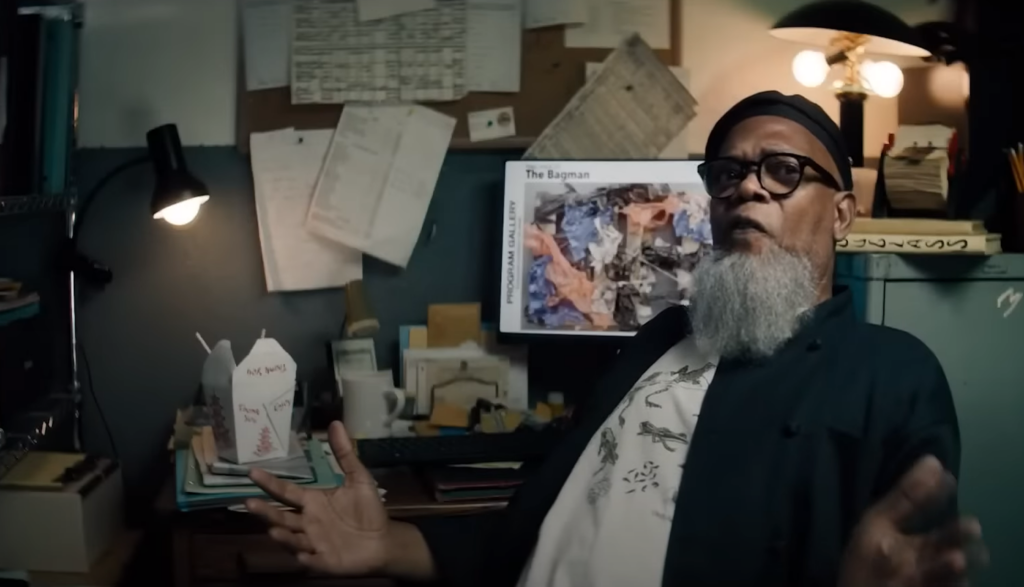
To some, art by the Bagman is worthless garbage. To others, it’s a commentary on “domestic violence, gender roles and an obvious hit piece on climate-change deniers.”
Well, the Bagman himself isn’t so sure about either of those views. But he does know that his work makes a killing.
And I mean that in the literal sense: The Bagman is a crime family’s hitman for hire, slaying his victims by choking them to death with plastic grocery bags. But with the IRS starting to look into family matters, it’s pretty difficult to justify how such large sums of money keep appearing in their pockets.
That’s why the family has turned to Patrice, an art dealer at a struggling gallery desperate to keep her exasperated clientele. They plan to make and sell art that their clients can buy in order to request hits so that the transaction looks more legitimate. Patrice understands the family wants to launder money, but she’s out of options to keep her gallery open. And as long as it remains on the down-low, everyone’s happy.
But the problem is that art is subjective. It turns out that rich people really like the angst, the crudeness and the anonymity of the Bagman’s work. He starts blowing up. And people begin demanding more and more from this trendy new “artist.” It’s not exactly what you want when you’re trying to keep a low profile with the IRS. And attention is never what a crime family wants.
There aren’t many positive elements when your film is centered around murder-for-hire and money laundering. That said, “The Bagman,” whose real name is Reggie, actually doesn’t want to be in the hitman business.
We learn that Reggie was forced into the job when he protected his sister from a drug dealer who was going to hurt her over an unpaid debt. And after Reggie killed the man, he was forced to become a member of the man’s crime family in order to “work off” what he’d done. And so, Reggie is always looking for a way out of the business.
Additionally, he protects Patrice when a man gets aggressive with her.
Reggie is Black and Jewish, and people call him the “Black Dreidel.”
We briefly see an older couple having sex, though nothing critical is seen, and the two are still in their clothes. We also hear a couple explicit references to having sex.
There’s a verbal reference to masturbation. Someone misunderstands a comment as an offer for sex. A woman and man both state that an art piece turns them on. A painting shows a nude woman’s breast. We hear a couple of slang references to the male anatomy.
A man sells urine-soaked lingerie on the Dark Web. He says that his money “goes through the Dark Web” and “comes out cleaner than a nun’s drawers.” A woman jokingly comments on how it’s too late for her to sell her eggs for money. A man is said to have a wife as well as many girlfriends.
We see a few scenes of various people being choked to death by a plastic bag over their heads. We watch as a couple of them fight for their lives—and one man’s death is broadcast for others to see.
Elsewhere, a woman’s neck is snapped. A man is punched in the face. Bloodstains are visible on the bags that Reggie uses for his art projects.
We’re told of some powerful “untouchable” people who are involved in sex trafficking and arms deals. A podcast describes someone whose head was bashed in with a doorknob. We hear a reference to an artist who uses his fame to harass women.
The f-word is used about 90 times, including eight instances that are preceded by “mother.” The s-word is used about 25 times. The c-word is used once. We also hear a couple crude words that reference male and female genitalia.
“A–” and “b–ch” are both used prominently. We also hear “d–n” and “h—.” God’s name is used in vain 15 times, including six pairings with “d–n.” Jesus’ name is used in vain five times.
Patrice is convinced that Reggie is a drug dealer. She has some reasons to believe so: She purchases Adderall from a dealer who has connections to Reggie. Patrice crushes an Adderall pill before ingesting it.
We also see people drinking various types of alcohol. A woman vapes.
Patrice vomits. A woman verbally attacks a man for being a “straight white male” when she becomes jealous of his success.
When the Bagman’s canvas is stained red, you’d better check to make sure it isn’t blood.
The Kill Room tells the story of a money laundering scheme taking place in an art gallery. But instead of laying low, the paintings the crime family sells are taking off.
And while there aren’t perhaps as many violent scenes in this movie as you might expect for such a premise, the occasional person still meets his or her demise in a plastic bag. There are also a few sexual quips and some drug use. But the biggest content culprit here is the foul language, which pervades nearly every sentence in this film.
Sometimes art speaks for itself. Other pieces of art speak to only some. And when it comes to the “art” of this movie … I just don’t get it.


Kennedy Unthank studied journalism at the University of Missouri. He knew he wanted to write for a living when he won a contest for “best fantasy story” while in the 4th grade. What he didn’t know at the time, however, was that he was the only person to submit a story. Regardless, the seed was planted. Kennedy collects and plays board games in his free time, and he loves to talk about biblical apologetics. He thinks the ending of Lost “wasn’t that bad.”